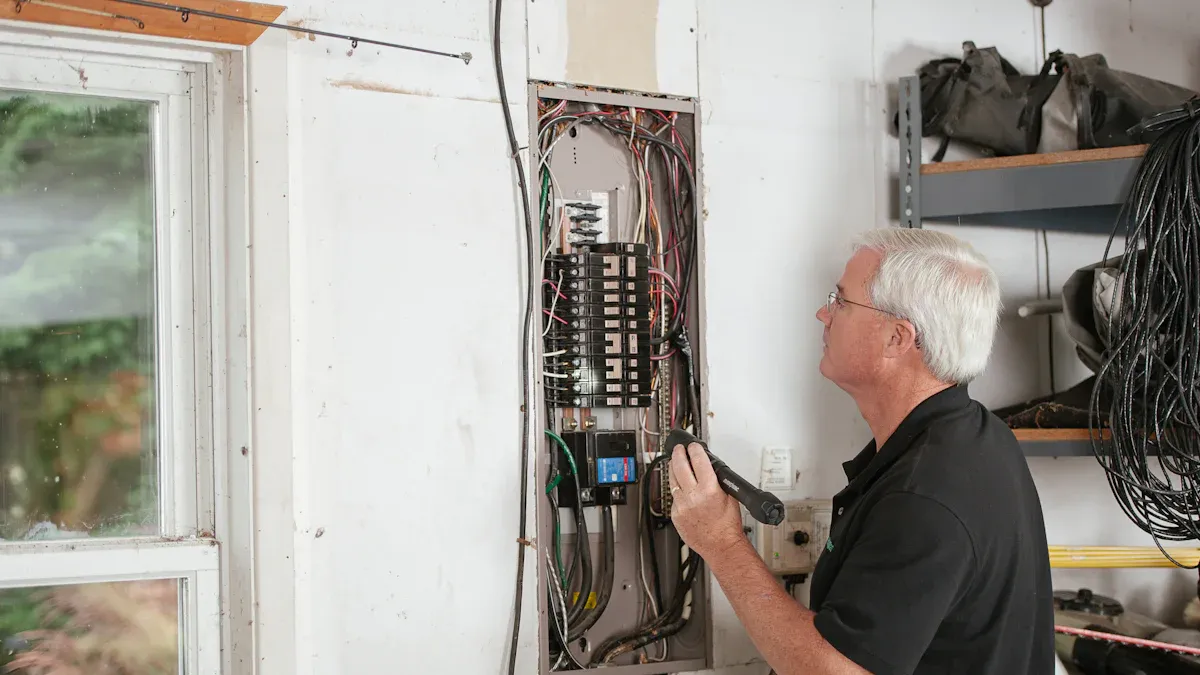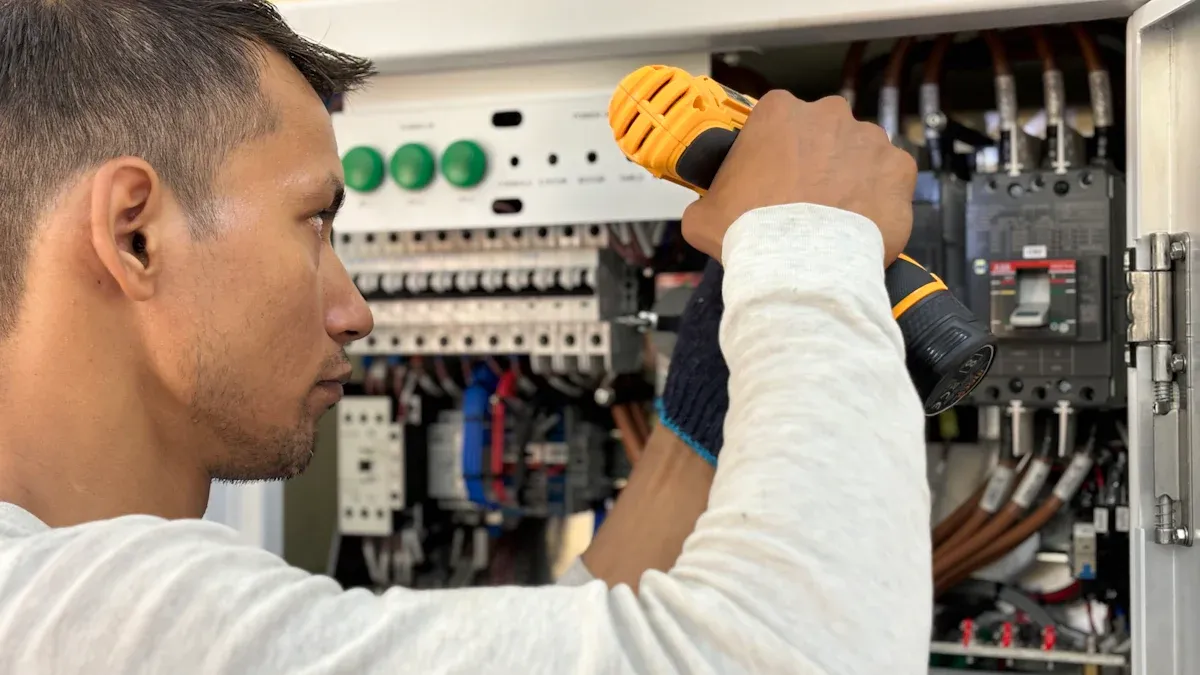You put in a new afci breaker, but it keeps tripping. This can be annoying. You are not the only one with this problem. Many people have the same issue. There are some common reasons for this. These include broken appliances, bad wiring, or too many things plugged in. Here are some of the top causes:
| Cause | Description |
|---|---|
| Faulty Appliances | Things like lamps with broken cords can make the breaker trip if not plugged in all the way. |
| Damaged Wiring | Nails in wires or animals chewing wires can make sparks and trip the breaker. |
| Faulty Wiring | Loose or wrong wiring can cause ground faults and short circuits. |
| Electrical Overload | Plugging in too many things can make the circuit too hot and trip the breaker. |
| Overheating Breaker | Bad connections can make the breaker get too hot and might start a fire. |
Don’t worry. Most of these problems are easy to fix. Let’s find out what is wrong with your breaker.
Key Takeaways
- Find out why your AFCI breaker keeps tripping. Check your appliances, wiring, and connections.
- Unplug things on the circuit that trips. See if one device is causing the problem.
- Look at outlets and switches for damage. Check for burn marks or warm spots.
- Make sure all wiring is tight and not broken. Loose or frayed wires can make the breaker trip.
- If you still have problems, call a licensed electrician. This helps keep you safe and gets repairs done right.
AFCI Breaker Causes

Faulty Appliances
Your afci breaker might trip when you use some appliances. This happens a lot with things like microwaves, washing machines, and vacuums. Treadmills and power tools can also cause it. These appliances have motors or electronics inside. Sometimes, they make small sparks when running. The afci breaker can think these sparks are dangerous arcs.
- Microwaves and washing machines often make the breaker trip for no real reason.
- Vacuums, treadmills, TVs, and fluorescent lights can also set off the breaker.
- Some homes have this problem a lot, but others never do.
If your breaker trips when you plug in one of these, the appliance might be why.
Damaged Wiring
Wiring problems are a big reason afci breakers trip. Wires can get hurt by nails, screws, or animals chewing on them. Old wires can crack or rust, letting electricity leak out.
- Loose wires and broken covers can let too much current flow.
- Wires that are frayed or not covered well can make sparks.
- Damaged wiring can trip the breaker to stop a fire.
If your house has old wiring or you think wires are damaged, this could be the cause.
Overloads
An overloaded circuit means too many things are plugged in. The afci breaker senses too much current and shuts off to keep you safe.
- Using lots of high-power devices at once can overload the circuit.
- Overloaded circuits get hot and can make covers melt.
- High resistance can make wires heat up to over 600° F.
You might see the breaker trip if you run a microwave, toaster, and coffee maker together.
Loose Connections
Loose connections in outlets, switches, or boxes can make your afci breaker trip. If wires are not tight, electricity cannot flow well and heat builds up.
Loose connections can make things overheat and spark. You might see warm or colored outlets, lights that flicker, or smell something burning.
If you notice these signs, a loose connection could be the problem.
Neutral Mixing
Neutral mixing happens when neutral wires from different circuits get joined together. The afci breaker needs each neutral wire to stay by itself to work right.
- Bad neutral connections can make the breaker trip.
- Mixing neutrals and grounds can make ground wires dangerous.
- Each circuit’s neutral must only connect to its own breaker.
| Requirement | Description |
|---|---|
| Neutral Separation | Circuit neutrals must stay apart for afci devices to work. |
| New Construction | All neutrals must be apart when leaving the panel. |
If you have shared or mixed neutrals, your breaker may trip a lot.
Backstabbed Outlets
Many homes have outlets where wires are pushed into holes in the back instead of using the side screws.
Backstabs are a quick and cheap way to attach wires. A small metal spring holds the wire, which can make it hot. Pushing wires into the box can strain them and make the contact smaller.
These connections can get loose over time. A loose backstabbed wire can spark and make your afci breaker trip, especially when using a lot of power.
Harmonics
Harmonics are weird currents or voltages that happen when devices use power in bursts, not smoothly. This can confuse your afci breaker.
- Harmonics come from microwaves, heaters, power tools, treadmills, and fluorescent lights.
- You might see lights flicker or transformers get too hot.
- Non-linear loads like special drives and inverters can mess up your electrical system.
If you have lots of electronics or machines, harmonics could be why your breaker trips.
Miswiring
Miswiring means wires are not hooked up the right way. This can happen when installing or fixing things.
- Always check wires before turning on the power.
- Use testers to make sure wires are in the right spots.
- Label wires so you do not get confused.
- Follow color rules for hot, neutral, and ground wires.
- Check everything with the plan and test the system.
Miswiring can make your afci breaker trip as soon as you turn on the circuit. Checking your wiring helps stop this problem.
AFCI Troubleshooting Steps

If your afci breaker keeps tripping, you can follow these steps to figure out what’s wrong. You don’t need to be an expert. Just take it one step at a time.
Identify Tripping Circuit
First, you need to know which circuit is causing the problem. Here’s what you can do:
- Open your electrical panel and look for the breaker that keeps tripping.
- Write down which rooms or outlets lose power when the breaker trips.
- If you have a Siemens Combination Type AFCI, check the LED trip indicators. These lights can show if the problem is arcing, arcing to ground, or just too much current.
- Try the Rule of Halves method. Break the circuit in the middle and see which half still trips. This helps you narrow down the trouble spot.
- Use an ohmmeter or digital multimeter (DMM) to check resistance between wires. Look for strange readings between hot, neutral, and ground.
Tip: If you hear humming noises or see flickering lights, pay extra attention to those areas.
Unplug Devices
Sometimes, the things you plug in can make the breaker trip. Here’s what you should do:
- Unplug everything from the outlets on the tripping circuit. This includes surge protectors, microwaves, vacuums, and even lights.
- Don’t forget about small devices like kids’ CB walkie-talkies. These can send low power signals that confuse the breaker.
- If you have a refrigerator or other big appliance on the same circuit, unplug it too.
- Wait a few minutes, then reset the breaker. If it stays on, plug in each device one at a time. Watch for the breaker to trip again.
Note: Municipal electrical inspectors say it’s best not to put lights on an afci circuit. Lights can trip the breaker by accident.
Inspect Outlets and Switches
Bad outlets and switches can cause problems. Look for these signs:
| Visual Sign | What It Means |
|---|---|
| Black marks or burn spots | Overheating or loose connections |
| Flickering lights | Possible wiring or breaker issue |
| Warm outlets or switches | Internal problems, risk of fire |
| Burning smells | Overheating, needs quick attention |
- Use the test button on the breaker to check if it works right.
- Look for loose wires or backstabbed connections. Move wires from the backstab holes to the screw terminals for a better connection.
- Check for melted or discolored outlets. Replace any that look damaged.
If you see scorch marks or smell burning, stop and call an electrician.
Check Wiring and Connections
Wiring problems are common. Here’s what you can check:
- Use a megger to test old wiring. Make sure neutrals are not shared with other circuits.
- Look for pinched, frayed, or cracked wires. Fix any insulation problems you find.
- Make sure each neutral wire connects only to its own breaker.
- Inspect all connections in outlets, switches, and junction boxes. Tighten any loose wires.
- Even with perfect wiring, outside signals like amateur radios can still trip the breaker.
Tip: If you’re not sure about wiring, ask a professional for help.
Test Breaker Reset
After you check everything, test the breaker:
- Press the test button on the afci breaker in your panel.
- If the breaker trips, reset it by flipping it off and then on.
- If it doesn’t trip, check if the breaker is installed right. If it still doesn’t work, you may need a new breaker.
- Use a tester with LEDs to check each outlet for proper wiring.
- Go to the outlet farthest from the panel and run an afci trip test with the tester.
Always use the test button to make sure your breaker works. This is the best way to check afci function.
If you follow these steps, you can find out what’s causing your breaker to trip. You might fix the problem yourself, or you might need help. Either way, you’ll know what to do next.
Fixes and Professional Help
DIY Solutions
You can do some easy things before calling an expert. First, unplug everything from the outlets on the circuit that keeps tripping. This helps you see if a device is causing trouble. Next, look at your outlets and switches for damage. Check for burn marks or wires that look loose. Make sure all wires are tight and not moving. If you find wires that are frayed or pinched, replace them fast. Moving wires from the backstab holes to the screw terminals can help a lot.
- Unplug every device to check if the breaker stays on.
- Look for damaged wires and make sure they are tight.
- Get rid of old or bad appliances if the breaker trips often.
Tip: Using newer appliances can help stop unwanted trips and keep your home safer.
When to Call an Electrician
Some problems need a licensed electrician to fix. You should not try these repairs yourself. Watch out for these signs:
- The breaker keeps tripping even after you unplug everything.
- You see melted outlets or smell something burning.
- You feel unsure about the wiring or connections.
- The breaker was not put in by a professional.
Safety is most important. If you see any of these signs, turn off the power to the circuit and call a licensed electrician right away. Doing repairs wrong can be very dangerous.
Prevent Future Tripping
You can do things to stop problems from happening again. Use smart devices made to prevent nuisance tripping. For example, a Leviton Smart Lock Pro AFCI Blank Face device can help. Plug important appliances like washers and microwaves into these devices for steady power. Always follow electrical codes when you add or change devices.
- Put in smart AFCI devices to stop unwanted trips.
- Plug main appliances into these devices for better power.
- Follow code rules to keep your system safe and current.
Checking and upgrading your system often keeps your home safe and your circuits working well.
You’ve learned what makes your breaker trip and what steps help you fix it. Most problems come from things like bad appliances, loose wires, or overloaded circuits. Careful checks and simple fixes solve many issues. If you still see trouble or feel unsure, call a licensed electrician. Remember, safety matters most. Stay alert and keep your home safe!
- Check devices and wiring first
- Ask for help if problems continue
- Put safety above all else
FAQ
What does it mean when my AFCI breaker trips instantly?
Your breaker trips right away because it senses a problem. You might have a wiring issue, a short circuit, or a miswired outlet. Check for loose wires or damaged devices before resetting.
What appliances can cause nuisance tripping?
Some appliances, like treadmills, vacuums, and microwaves, can trip your AFCI breaker. These devices create small electrical arcs or harmonics that confuse the breaker. Try unplugging them to see if the problem stops.
What should I do if I smell burning near an outlet?
Stop using the outlet right away. Turn off the breaker for that circuit. Call a licensed electrician to check for damage. Burning smells mean there could be a fire risk.
What is the test button on my AFCI breaker for?
You use the test button to check if your breaker works. Press it to make sure the breaker trips. If it does not trip, your breaker might be faulty and need replacement.
See also
How to Identify Arc Faults in Circuit Breakers for Home Safety
How to Identify Arc Fault Locations Step by Step
How to determine if the AFCI circuit breaker is damaged?
What You Need to Know About Arc Faults and Fire Hazards
What are the three facts about the heating of AFCI circuit breakers



